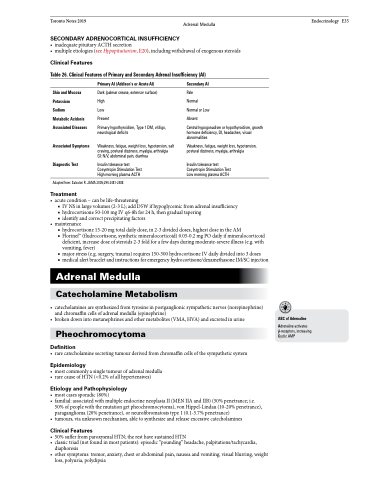Page 277 - TNFlipTest
P. 277
Toronto Notes 2019 Adrenal Medulla
SECONDARY ADRENOCORTICAL INSUFFICIENCY
• inadequatepituitaryACTHsecretion
• multipleetiologies(seeHypopituitarism,E20),includingwithdrawalofexogenoussteroids
Clinical Features
Table 26. Clinical Features of Primary and Secondary Adrenal Insufficiency (AI)
Endocrinology E35
Skin and Mucosa Potassium
Sodium
Metabolic Acidosis Associated Diseases
Associated Symptoms Diagnostic Test
Primary AI (Addison’s or Acute AI)
Dark (palmar crease, extensor surface) High
Low
Present
Primary hypothyroidism, Type 1 DM, vitiligo, neurological deficits
Weakness, fatigue, weight loss, hypotension, salt craving, postural dizziness, myalgia, arthralgia
GI: N/V, abdominal pain, diarrhea
Insulin tolerance test Cosyntropin Stimulation Test High morning plasma ACTH
Secondary AI
Pale
Normal
Normal or Low
Absent
Central hypogonadism or hypothyroidism, growth hormone deficiency, DI, headaches, visual abnormalities
Weakness, fatigue, weight loss, hypotension, postural dizziness, myalgia, arthralgia
Insulin tolerance test Cosyntropin Stimulation Test Low morning plasma ACTH
Adapted from: Salvatori R. JAMA 2005;294:2481-2488
Treatment
• acutecondition–canbelife-threatening
■ IV NS in large volumes (2-3 L); add D5W if hypoglycemic from adrenal insufficiency ■ hydrocortisone 50-100 mg IV q6-8h for 24 h, then gradual tapering
■ identify and correct precipitating factors
• maintenance
■ hydrocortisone 15-20 mg total daily dose, in 2-3 divided doses, highest dose in the AM
■ FlorinefTM (fludrocortisone, synthetic mineralocorticoid) 0.05-0.2 mg PO daily if mineralocorticoid
deficient, increase dose of steroids 2-3 fold for a few days during moderate-severe illness (e.g. with
vomiting, fever)
■ major stress (e.g. surgery, trauma) requires 150-300 hydrocortisone IV daily divided into 3 doses
■ medicalalertbraceletandinstructionsforemergencyhydrocortisone/dexamethasoneIM/SCinjection
Adrenal Medulla
Catecholamine Metabolism
• catecholaminesaresynthesizedfromtyrosineinpostganglionicsympatheticnerves(norepinephrine) and chromaffin cells of adrenal medulla (epinephrine)
• brokendownintometanephrinesandothermetabolites(VMA,HVA)andexcretedinurine
Pheochromocytoma
Definition
• rarecatecholaminesecretingtumourderivedfromchromaffincellsofthesympatheticsystem
Epidemiology
• mostcommonlyasingletumourofadrenalmedulla • rarecauseofHTN(<0.2%ofallhypertensives)
Etiology and Pathophysiology
• mostcasessporadic(80%)
• familial:associatedwithmultipleendocrineneoplasiaII(MENIIAandIIB)(50%penetrance;i.e.
50% of people with the mutation get pheochromocytoma), von Hippel-Lindau (10-20% penetrance),
paraganglioma (20% penetrance), or neurofibromatosis type 1 (0.1-5.7% penetrance)
• tumours,viaunknownmechanism,abletosynthesizeandreleaseexcessivecatecholamines
Clinical Features
• 50%sufferfromparoxysmalHTN;theresthavesustainedHTN
• classictriad(notfoundinmostpatients):episodic“pounding”headache,palpitations/tachycardia,
diaphoresis
• othersymptoms:tremor,anxiety,chestorabdominalpain,nauseaandvomiting,visualblurring,weight
ABC of Adrenaline
Adrenaline activates β-receptors, increasing Cyclic AMP
loss, polyuria, polydipsia


